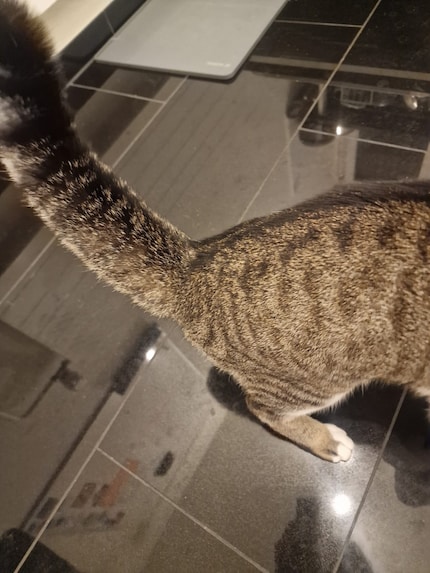
Guide
Why your cat gets the zoomies
by Darina Schweizer

Occasionally, my cat’s tail looks like a raccoon’s – all bushy and fluffed up. Here’s what’s behind this sudden transformation.
Every few days, a raccoon turns up at my house. He resembles my cat Jasper, but his tail’s at least twice as thick. The hair on its elongated spine usually puffs up when the rascal’s chasing ping-pong balls or his cat friend Joy. But why?
Before I start researching, I dread googling «fat tail» and «cat» in the office. I dare to do it anyway, and things become even more ambiguous. Apparently, the phenomenon is called piloerection (page in German). I immediately laugh out loud. I find out (page in German) that the muscles at the hair roots of the tail – often also those on the back and neck – contract when the animal is anxious or aggressive. This causes the hair to stand up. The cat wants to make itself big and intimidate enemies.

The process doesn’t happen consciously, but automatically via the autonomic nervous system. This autopilot, which regulates internal processes such as breathing or digestion, also triggers goose bumps in humans. Usually, this happens when it’s cold or we’re emotional (like I was when I saw this). In other words, a piloerection is a feline goose bump.
What still bothers me is the trigger. When Jasper runs around like a madman, he doesn’t seem frightened or aggressive to me, rather wild and exuberant. «Even when two cats playfully chase each other, the tail is usually thick and bristly,» I read on (page in German). I see. So if your cat mutates into a raccoon while playing, it may simply be a bit overexcited. Similar to the zoomies:
You can easily distinguish this from fear and aggression: the rest of the cat’s body remains as usual. No hump, no flat ears, no hissing. The same goes for Jasper. I’m relieved. His bushy tail alone isn’t an alarm sign. The piloerection is just a fluffy sign of happy playtime.
When does your cat’s tail fluff up? Let us know in the comments!
I love anything with four legs or roots - especially my shelter cats Jasper and Joy and my collection of succulents. My favourite things to do are stalking around with police dogs and cat coiffeurs on reportages or letting sensitive stories flourish in garden brockis and Japanese gardens.
Practical solutions for everyday problems with technology, household hacks and much more.
Show all